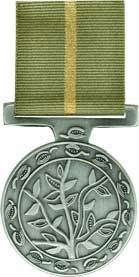The Humanitarian Overseas Service Medal is an award in the Australian honours system. The award is presented to those who perform humanitarian service in a foreign country, in particular those working in dangerous environments or conditions or during a humanitarian crisis. The award was introduced by letters patent on 16 April 1999, following a review of the Australian honours and awards system beginning in 1995.
Potential recipients have to prove they worked for a minimum of 30 days in the location depicted by the clasp, during a period of time set in the award criteria. In addition, potential recipients have to be working for an aid organisation recognised by the criteria or with a United Nations taskforce during that timeframe. In 2005, special criteria were established for people working during the 2004 Indian Ocean earthquake or the 2005 Nias–Simeulue earthquake, with a maximum time period of 7 or 14 days depending on the time frame.
The medal was originally intended as a civilian award, in parallel with the Australian Service Medal and the Police Overseas Service Medal, and until 2005 the Australian Defence Force had never been declared an eligible organisation. This is because, in most cases, the Australian Service Medal is already available to military personnel serving alongside humanitarian relief operations. However, defence personnel on leave of absence and serving an eligible organisation could qualify for the medal. The declaration of eligible organisations for the Indian Ocean clasp was the first time the Australian Defence Force was declared an eligible organisation, as Operation Sumatra Assist was purely a disaster relief operation and did not attract any military operational service award. The Australian Defence Force was again declared an eligible organisation for the participation of its personnel in Operation Pakistan Assist, part of the Australian humanitarian response to the 8 October 2005 Pakistan earthquake.
The Humanitarian Overseas Service Medal is a circular medal. The obverse features a stylised eucalyptus tree in the centre, with its branches reaching to the edge of the medal. A pattern of gumnuts rings the eucalyptus.The reverse has the same pattern of gumnuts around the rim, with the name of the recipient engraved.The ribbon is eucalyptus green, divided vertically by a gold stripe. These colours are associative with the green and gold, the national colours of Australia, while continuing with the eucalyptus theming; symbolising hope and regeneration after the disaster.Nineteen clasps have been declared for the Humanitarian Overseas Service Medal as of May 2010, to indicate what region(s) the recipient worked in. These are detailed below:
Afghanistan30 days service with civilian organisations in Afghanistan from 8 December 1979 to present
Balkans30 days civilian service in the period;
Zone 1 – Bosnia and Herzegovina, Croatia, Montenegro and Serbia – from 21 February 1992 to presentZone 2 – Serbia, Kosovo, Albania, Republic of Macedonia – from 24 March 1999 to presentBritish Comunbia14 days service in Canada with civilian organisations from 3 August 2009 to 6 September 2009. Following wildfires in British Coliumbia, Canada
Cambodia30 days service in
Cambodia with civilian organisations from 1 July 1979 to 31 December 1993
Christchurch14 days service with civilian rescue agencies or State and Territory police agencies from 22 February 2011 to 26 May 2011 following the
2011 Christchurch earthquake in New Zealand
East Timor30 days service with civilian organisations in East Timor from 1 June 1999 to 19 May 2002
Great Lakes30 days service with civilian organisations in the African Great Lakes area from 1 May 1994 to Present
Haiti14 days service with civilian organisations in
Haiti from 12 January 2010 to 15 March 2010. Following a Hurricane
Indian OceanCivilian, Police and Military service providing assistance following the 2004 Indian Ocean earthquake
7 days service in the period 26 December 2004 – 8 January 200514 days service in the period 26 December 2004 – 12 February 2005Civilian and Military service providing assistance following the
2005 Nias–Simeulue earthquake7 days service in the period 28 March 2005 – 18 April 2005Iraq30 days service with civilian organisations in
Iraq from 20 March 2003 to Present
Japan14 days service with civilian and rescue agencies from 11 March 2011 to 27 May 2011 following the
2011 Tōhoku earthquake and tsunamiMozambique30 days service with civilian organisations in
Mozambique from 10 October 1985 to 31 January 1995
Northern Iraq30 days service with civilian organisations in Northern Iraq from 1 February 1991 to 31 May 1995
PakistanCivilian and Military assistance following the 2005 Pakistan earthquake
14 days service in the period 8 October 2005 – 8 November 200530 days service in the period 8 October 2005 – 31 May 2006Pakistan II14 days service with civilian and military agencies from 6 August 2010 to 8 November 2010 following the 2010 Pakistan flood
Samoa7 days service with civilian, police and rescue agencies from 29 September 2009 to 10 October 2009 following the
2009 Samoa earthquake and tsunamiSomalia30 days service with civilian organisations in
Somalia from 1 March 1992 to 1 January 1996
South Sudan30 days service with civilian organisations in Southern
Sudan from 23 May 1992
South Vietnam30 days service with civilian organisations
South Vietnam from 29 May 1964 to 30 April 1975
As of 30 June 2010, 1,993 awards, including medals and additional clasps, had been made.
Notable recipients of this award include:
Father Frank Brennan SJ, AO, clasp awarded in 2002, for his work as Director of the Jesuit Refugee Service in East TimorAndrew MacLeodmilitary personnel involved in Operation Sumatra Assist I and II who meet the eligibility criteriathe eleven ADF personnel involved in the 2005 Nias Island WS-61 Sea King crash, including the nine that diedDeclared eligible organisations must be part of an Australian humanitarian response, or an Australian contingent to an international response. Accordingly, it is possible for non-Australians participating in such a group to be eligible for the medal.

